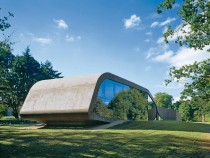
© Roland Halbe
In 1918, collector Wilhelm Hansen had his private home Ordrupgaard erected in the north of Copenhagen, together with a gallery wing to the east for the presentation of his extensive collection of French Impressionist and Fauvist paintings. The growth of the collection, now in the possession of the Danish state, made an extension of the gallery necessary. At the same time, this presented an opportunity to redefine the formal dialogue between the building and the gardens. Set adjoining the old gallery, the new structure appears to enter into a unity with the topography. The black exposed concrete surfaces play a major role in the restrained manner of the extension, although roughly 500m2 are added to the exhibition space, doubling the existing area. From the north-west, visitors have access to the foyer with a museum shop, while a narrow corridor leads to the area for temporary exhibitions to the north. This gallery, like the cabinet spaces for permanent exhibits, is introverted and without windows. Daylight penetrates solely via narrow rooflight strips, creating a calm atmosphere that focuses attention on the pictures




